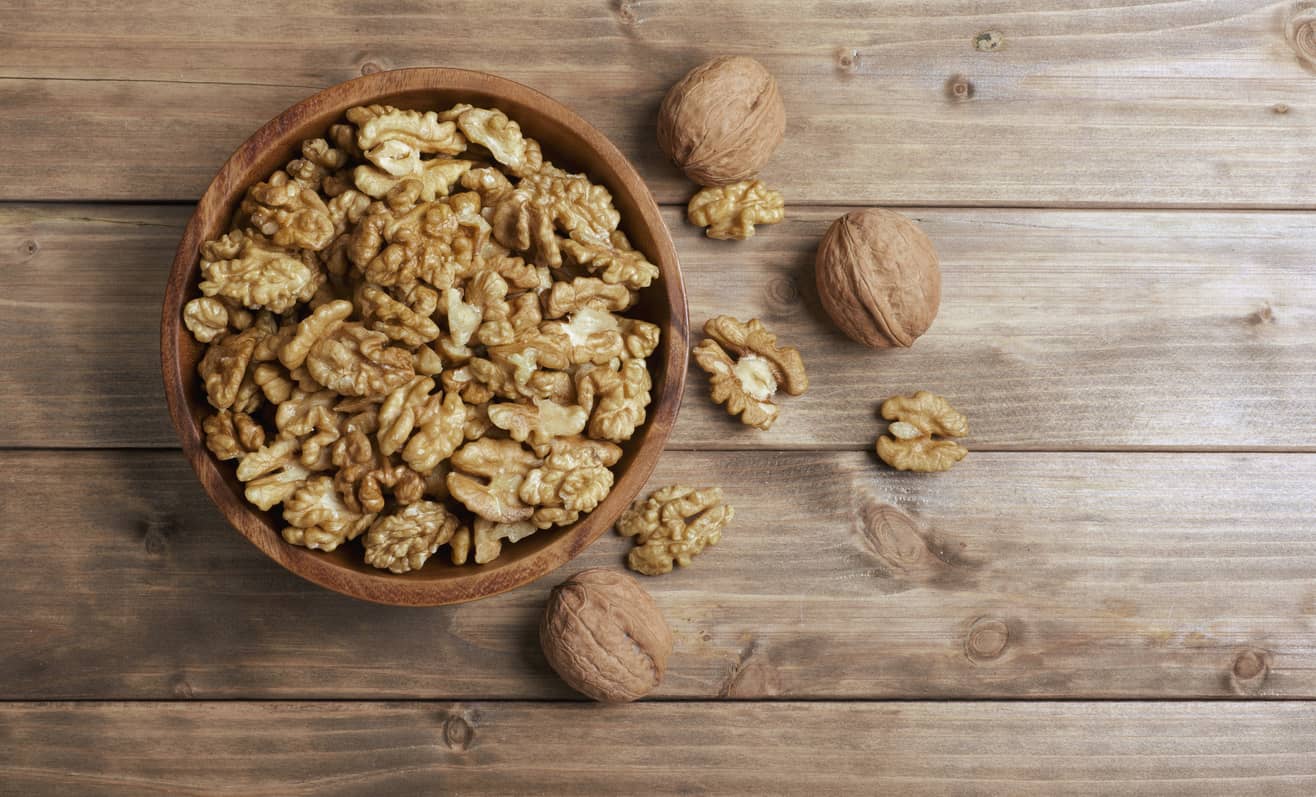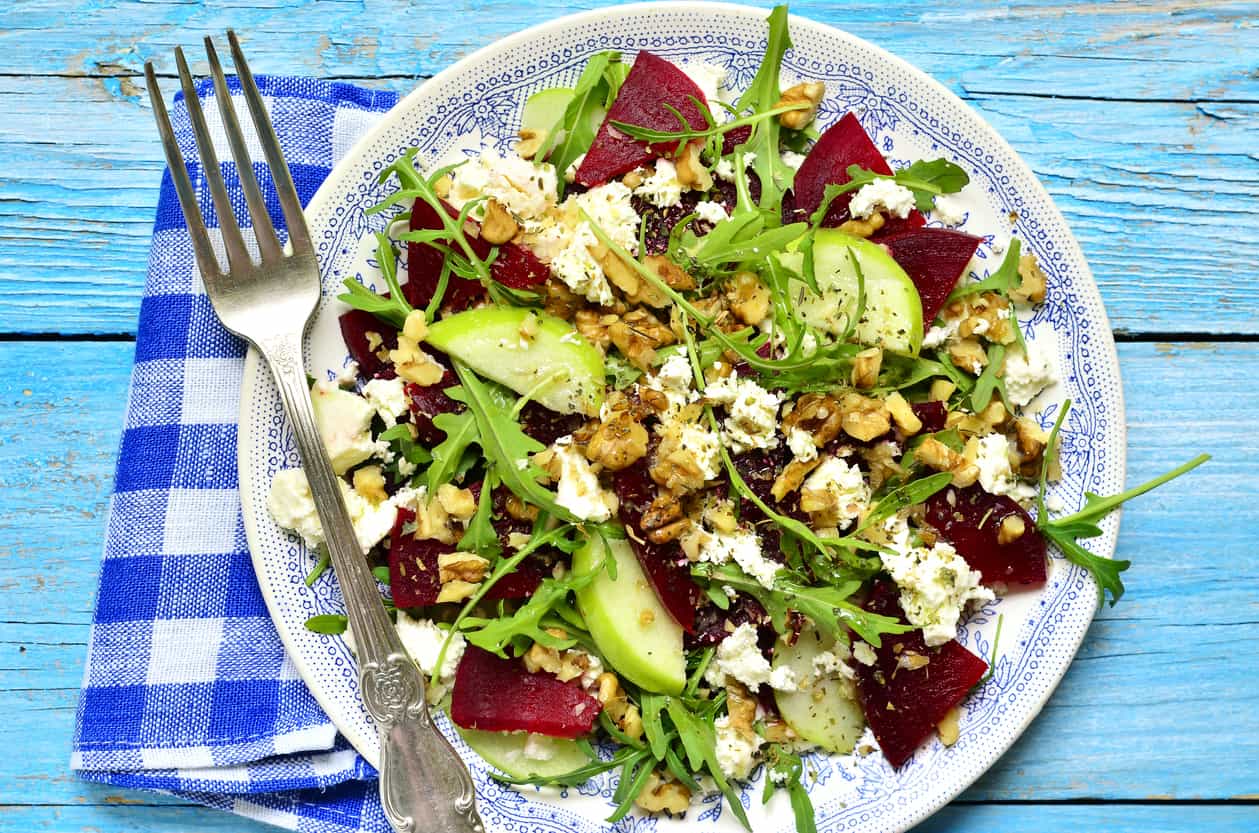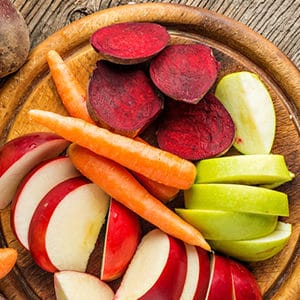Fifteen years ago, when I was helping write the content for the debut of The World’s Healthiest Foods, the first two World’s Healthiest Foods I wrote up were apples and beets. Thinking, why not pair them and get double the benefits in one delicious salad, I added walnuts to the mix and created this recipe, which has been a family favorite ever since.
The Health Benefits of Apples and Beets
Even back then, substantial research had identified both apples and beets as superfoods, each with an exceptional array of cardiovascular and other health benefits. Today, we know much more about the many mechanisms through which beets and apples lower blood pressure, improve vascular (blood vessel) function and our cholesterol profile, fight inflammation, feed the healthy bacteria in our digestive tract, and help prevent not only cardiovascular disease, but diabetes, cancer – and osteoporosis.
Far less research has focused specifically on the bone health effects of these 2 superfoods, but you don’t have to be Einstein to see the clear connections. Both apples and beets¹ exert serious inflammation-lowering effects² and improve digestive tract health and function.
Chronic low-grade inflammation excessively activates osteoclasts, the special cells that break down (resorb) bone, and when our digestion is compromised, so is our absorption of the nutrients our bones require to rebuild.
Plus, fiber compounds in both apples and beets feed the healthy bacteria in our digestive tract that produce some vitamin K2 for us. Vitamin K2 is essential for healthy bones because it activates the proteins that pull calcium into our bones (the vitamin K-dependent protein, osteocalcin) and keep it out of our blood vessels (the vitamin K-dependent protein, matrix Gla protein).
Below, I’ve listed just a few of the most recently published medical journal articles as references – the first two, which are reviews encompassing the results of many studies, are free access on PubMedCentral. I’ve provided links to these papers for you. Scan these two articles, and I guarantee you will want to make apples and beets staples in your diet.
The other references report research showing:
- An inverse correlation between eating apples and all-cause and disease-specific mortality – in other words, eat more apples and lower your risk of death from not just heart disease, but everything!
- A phytonutrient in apples called phloridzin prevents bone loss in ovariectomized rats (animals whose ovaries were removed to simulate postmenopausal women) under inflammation-producing conditions (in other words, like real life for most of us).
- Beets protected mice exposed to radiation, maintaining their bone marrow’s ability to produce immune cells.

Don’t Forget About Walnuts…
- Walnuts lower LDL and blood pressure, two major risk factors for cardiovascular disease. Walnuts lower LDL cholesterol (by ∼9-16%) and blood pressure (diastolic blood pressure by ∼2-3 mm Hg). Plus, walnuts improve the function of the endothelium* (the lining of our blood vessels), decrease damage caused by free radicals, lower several markers of inflammation, and increase cholesterol efflux (the removal of cholesterol from the vasculature).
The endothelium is a major player in your cardiovascular health and that of your bones.
This one-cell-thick layer lines your entire circulatory system, from your heart to your smallest capillaries, and determines blood vessel tone (how uptight your blood vessels are and whether they can effectively dilate/relax). Your endothelium also regulates fluid filtration, for example, in the kidneys, so kidney health (and your ability to convert vitamin D into 1,25-D, its hormonal form in which it enables active absorption of calcium from the intestines) is dependent on the health of your endothelium.
In sum, beets, apples, and walnuts combine to give your heart (and bones) a health boost.
Just one example of the synergy here: one of the ways in which beets boost cardiovascular health is via their unique beneficial effects on the endothelium. Beets are extremely rich in a form of nitrate that our bodies convert to a compound called nitric oxide, which relaxes the endothelium, improving blood flow.
One caveat regarding apples – eat organic apples only! Conventionally raised apples rank #2 on the Dirty Dozen, the Environmental Working Group’s list of the foods most contaminated with pesticide residues. Pesticides are endocrine-disruptors and promote inflammation and cancer. Avoid them! Organically grown foods are not only free of pesticides, but contain far greater amounts of minerals and phytonutrients. I wrote about the research confirming this in Your Bones, 2nd edition, pgs. 268-70.


Apple and Beet Salad
Ingredients
- 2 large organic red beets (or 4 medium-sized)
- 2 medium to large organic apples (your choice, I prefer 1 Granny Smith & 1 Braeburn or Fuji)
- 1 bunch organic scallions (6-8 scallions)
- 1/2 cup organic walnuts lightly toasted
- 3/4 oz organic feta cheese (from pastured sheep or cows, crumbled*)
Dressing
- 3 tbsp organic olive oil extra virgin
- 1 tbsp organic lemon juice
- 2-3 tbsp organic balsamic vinegar
Optional
- 1 tsp organic gluten-free tamari sauce (to season walnuts)
- 1 cup arugula (or mustard greens)
- Organic Italian parsley (few sprigs for garnish & even more phytonutrients and minerals)
Instructions
- Rinse beets under cold running water and cut in half or, if very large, in quarters. Beet juice can tint your skin pink, so wear kitchen gloves or just wash your hands well afterward. If any pink tint remains, a paper towel moistened with lemon juice will quickly remove it.
- Place a steamer rack in the bottom of your pot, add 2-3 inches of water to the pot and bring to a rolling boil. Add beets, cover, and steam for 15 minutes. Remove from the heat, cover the pot, and let cool. The beets will cook a bit more while cooling.
- While beets are steaming and cooling, prepare the apples and scallions.
- Rinse both under cold running water. Cut the apples in half, remove & discard the core, place the cut side of the apple down on your cutting board, and slice lengthwise, then crosswise, so you end up with bite-sized pieces. Transfer to a large glass or ceramic (not plastic!*) bowl and add the lemon juice; this will both flavor the apples, add some vitamin C, and keep them from turning brown. (*Toxic compounds leach from plastic into food, particularly when acidic components like lemon juice or vinegar and/or fats, like olive oil or cheese, are present.)
- Trim the root end from the scallions, slip off the outermost skin, then slice the scallion into small pieces and add them to the bowl with the apples. By now, your beets should be cool enough to handle easily. Wearing your kitchen gloves, transfer the beets to your cutting board and gently slip off their skin with your fingers. Discard the skin. Place the beets flat side down and cut, first lengthwise, then crosswise, for bite-sized pieces. Add the beets to the bowl with your apples and scallions.
- Toss the apples and beets with balsamic vinegar till well distributed, then add the olive oil and toss again to coat the beets and apples well. Taste and add more balsamic and/or olive oil if desired.
- Toss the walnuts with 1 teaspoon gluten-free Tamari—if desired – spread them over a baking pan and toast in your toaster oven or in your oven. If using the oven, set it to roast at 250 degrees for 5-10 minutes. Or you can toast the walnuts in a frying pan over medium heat, stirring them frequently. Your frying pan should be stainless steel or iron, not non-stick. Non-stick pans emit fumes containing toxic chemicals when heated.
- Regardless of the method chosen, watch your walnuts as they can burn easily. (I speak from sad experiences here!) As soon as the walnuts’ color deepens, and you can smell their lovely nutty aroma, your walnuts are ready. Toast extra walnuts while you’re at it and save them in a glass storage container in the refrigerator (not plastic!) to add to salads, granola, yogurt and fruit, etc., or for a heart-healthy snack.
- Crumble the feta cheese and sprinkle over the beet-apple mixture, then top with the toasted walnuts. Garnish with a few sprigs of Italian parsley, if desired, and serve.
Notes
- 0.6 grams omega-3 (alpha linolenic acid)
- 2 grams omega-6 (linoleic acid)
- 8 mg choline
- 53 mcg folate
- 75 mcg beta-carotene
- 116 mcg lutein + zeaxanthin
- 14 mcg retinol (vitamin A)
- 20 mcg vitamin K1
Nutrition
References
- Clifford T, Howatson G, West DJ, et al. The potential benefits of red beetroot supplementation in health and disease. Nutrients. 2015 Apr 14;7(4):2801-22. doi: 10.3390/nu7042801. PMID: 25875121 PMCID: PMC4425174 https://www.ncbi.nlm.nih.gov/pubmed/?term=PMC4425174
- Koutsos A, Tuohy KM, Lovegrove JA. Apples and cardiovascular health–is the gut microbiota a core consideration? Nutrients. 2015 May 26;7(6):3959-98. doi: 10.3390/nu7063959. PMID: 26016654 PMCID: PMC4488768 https://www.ncbi.nlm.nih.gov/pubmed/26016654
- Hodgson JM, Prince RL, Woodman RJ, et al. Apple intake is inversely associated with all-cause and disease-specific mortality in elderly women. Br J Nutr. 2016 Mar 14;115(5):860-7. doi: 10.1017/S0007114515005231. Epub 2016 Jan 20. PMID: 26787402
- Chai SC, Hooshmand S, Saadat RL, et al. Daily apple versus dried plum: impact on cardiovascular disease risk factors in postmenopausal women. J Acad Nutr Diet. 2012 Aug;112(8):1158-68. doi: 10.1016/j.jand.2012.05.005. PMID: 22818725
- Puel C, Quintin A, Mathey J, et al. Prevention of bone loss by phloridzin, an apple polyphenol, in ovariectomized rats under inflammation conditions. Calcif Tissue Int. 2005 Nov;77(5):311-8. Epub 2005 Nov 16. PMID: 16307390
- Cho J, Bing SJ, Kim A, et al. Beetroot (Beta vulgaris) rescues mice from γ-ray irradiation by accelerating hematopoiesis and curtailing immunosuppression. Pharm Biol. 2017 Dec;55(1):306-319. PMID: 27927068





Lisa
October 12, 2018 , 6:29 amThey claim beets have POTASSIUM ,so why is it NOT listed on this?????